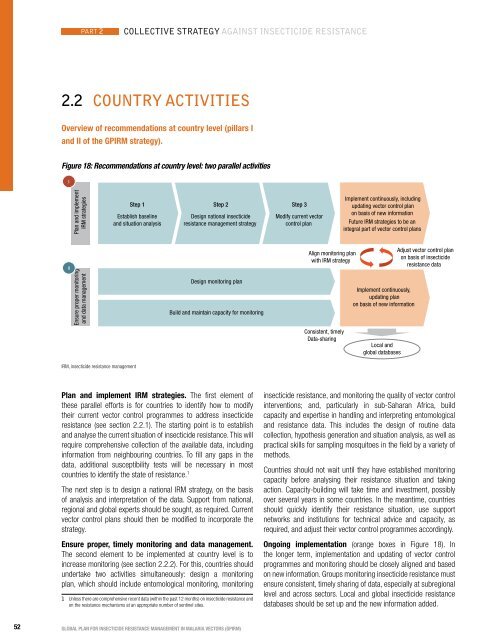Global plan for insecticide resistance management in malaria vectors
Global plan for insecticide resistance management in malaria vectors
Global plan for insecticide resistance management in malaria vectors
- No tags were found...
Create successful ePaper yourself
Turn your PDF publications into a flip-book with our unique Google optimized e-Paper software.
Part 2Collective strategy aga<strong>in</strong>st <strong><strong>in</strong>secticide</strong> <strong>resistance</strong>2.2 Country activitiesOverview of recommendations at country level (pillars Iand II of the GPIRM strategy).Figure 18: Recommendations at country level: two parallel activitiesIPlan and implementIRM strategiesStep 1Establish basel<strong>in</strong>eand situation analysisStep 2Design national <strong><strong>in</strong>secticide</strong><strong>resistance</strong> <strong>management</strong> strategyStep 3Modify current vectorcontrol <strong>plan</strong>Implement cont<strong>in</strong>uously, <strong>in</strong>clud<strong>in</strong>gupdat<strong>in</strong>g vector control <strong>plan</strong>on basis of new <strong>in</strong><strong>for</strong>mationFuture IRM strategies to be an<strong>in</strong>tegral part of vector control <strong>plan</strong>sIIEnsure proper monitor<strong>in</strong>gand data <strong>management</strong>IRM, <strong><strong>in</strong>secticide</strong> <strong>resistance</strong> <strong>management</strong>Design monitor<strong>in</strong>g <strong>plan</strong>Build and ma<strong>in</strong>ta<strong>in</strong> capacity <strong>for</strong> monitor<strong>in</strong>gAlign monitor<strong>in</strong>g <strong>plan</strong>with IRM strategyConsistent, timelyData-shar<strong>in</strong>gImplement cont<strong>in</strong>uously,updat<strong>in</strong>g <strong>plan</strong>on basis of new <strong>in</strong><strong>for</strong>mationLocal andglobal databasesAdjust vector control <strong>plan</strong>on basis of <strong><strong>in</strong>secticide</strong><strong>resistance</strong> dataPlan and implement IRM strategies. The first element ofthese parallel ef<strong>for</strong>ts is <strong>for</strong> countries to identify how to modifytheir current vector control programmes to address <strong><strong>in</strong>secticide</strong><strong>resistance</strong> (see section 2.2.1). The start<strong>in</strong>g po<strong>in</strong>t is to establishand analyse the current situation of <strong><strong>in</strong>secticide</strong> <strong>resistance</strong>. This willrequire comprehensive collection of the available data, <strong>in</strong>clud<strong>in</strong>g<strong>in</strong><strong>for</strong>mation from neighbour<strong>in</strong>g countries. To fill any gaps <strong>in</strong> thedata, additional susceptibility tests will be necessary <strong>in</strong> mostcountries to identify the state of <strong>resistance</strong>. 1The next step is to design a national IRM strategy, on the basisof analysis and <strong>in</strong>terpretation of the data. Support from national,regional and global experts should be sought, as required. Currentvector control <strong>plan</strong>s should then be modified to <strong>in</strong>corporate thestrategy.Ensure proper, timely monitor<strong>in</strong>g and data <strong>management</strong>.The second element to be implemented at country level is to<strong>in</strong>crease monitor<strong>in</strong>g (see section 2.2.2). For this, countries shouldundertake two activities simultaneously: design a monitor<strong>in</strong>g<strong>plan</strong>, which should <strong>in</strong>clude entomological monitor<strong>in</strong>g, monitor<strong>in</strong>g1 Unless there are comprehensive recent data (with<strong>in</strong> the past 12 months) on <strong><strong>in</strong>secticide</strong> <strong>resistance</strong> andon the <strong>resistance</strong> mechanisms at an appropriate number of sent<strong>in</strong>el sites.<strong><strong>in</strong>secticide</strong> <strong>resistance</strong>, and monitor<strong>in</strong>g the quality of vector control<strong>in</strong>terventions; and, particularly <strong>in</strong> sub-Saharan Africa, buildcapacity and expertise <strong>in</strong> handl<strong>in</strong>g and <strong>in</strong>terpret<strong>in</strong>g entomologicaland <strong>resistance</strong> data. This <strong>in</strong>cludes the design of rout<strong>in</strong>e datacollection, hypothesis generation and situation analysis, as well aspractical skills <strong>for</strong> sampl<strong>in</strong>g mosquitoes <strong>in</strong> the field by a variety ofmethods.Countries should not wait until they have established monitor<strong>in</strong>gcapacity be<strong>for</strong>e analys<strong>in</strong>g their <strong>resistance</strong> situation and tak<strong>in</strong>gaction. Capacity-build<strong>in</strong>g will take time and <strong>in</strong>vestment, possiblyover several years <strong>in</strong> some countries. In the meantime, countriesshould quickly identify their <strong>resistance</strong> situation, use supportnetworks and <strong>in</strong>stitutions <strong>for</strong> technical advice and capacity, asrequired, and adjust their vector control programmes accord<strong>in</strong>gly.Ongo<strong>in</strong>g implementation (orange boxes <strong>in</strong> Figure 18). Inthe longer term, implementation and updat<strong>in</strong>g of vector controlprogrammes and monitor<strong>in</strong>g should be closely aligned and basedon new <strong>in</strong><strong>for</strong>mation. Groups monitor<strong>in</strong>g <strong><strong>in</strong>secticide</strong> <strong>resistance</strong> mustensure consistent, timely shar<strong>in</strong>g of data, especially at subregionallevel and across sectors. Local and global <strong><strong>in</strong>secticide</strong> <strong>resistance</strong>databases should be set up and the new <strong>in</strong><strong>for</strong>mation added.52GLOBAL PLAN FOR INSECTICIDE RESISTANCE MANAGEMENT IN MALARIA VECTORS (GPIRM)
















